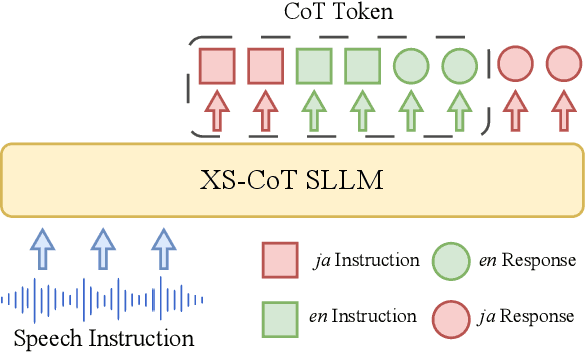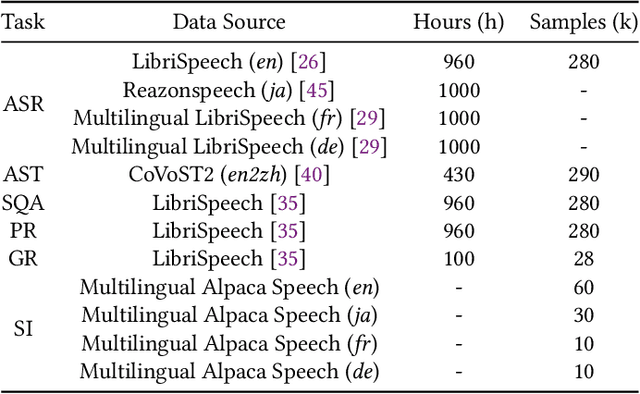Hongfei Xue
The TEA-ASLP System for Multilingual Conversational Speech Recognition and Speech Diarization in MLC-SLM 2025 Challenge
Jul 24, 2025Abstract:This paper presents the TEA-ASLP's system submitted to the MLC-SLM 2025 Challenge, addressing multilingual conversational automatic speech recognition (ASR) in Task I and speech diarization ASR in Task II. For Task I, we enhance Ideal-LLM model by integrating known language identification and a multilingual MOE LoRA structure, along with using CTC-predicted tokens as prompts to improve autoregressive generation. The model is trained on approximately 180k hours of multilingual ASR data. In Task II, we replace the baseline English-Chinese speaker diarization model with a more suitable English-only version. Our approach achieves a 30.8% reduction in word error rate (WER) compared to the baseline speech language model, resulting in a final WER of 9.60% in Task I and a time-constrained minimum-permutation WER of 17.49% in Task II, earning first and second place in the respective challenge tasks.
AI-Assisted Rapid Crystal Structure Generation Towards a Target Local Environment
Jun 09, 2025Abstract:In the field of material design, traditional crystal structure prediction approaches require extensive structural sampling through computationally expensive energy minimization methods using either force fields or quantum mechanical simulations. While emerging artificial intelligence (AI) generative models have shown great promise in generating realistic crystal structures more rapidly, most existing models fail to account for the unique symmetries and periodicity of crystalline materials, and they are limited to handling structures with only a few tens of atoms per unit cell. Here, we present a symmetry-informed AI generative approach called Local Environment Geometry-Oriented Crystal Generator (LEGO-xtal) that overcomes these limitations. Our method generates initial structures using AI models trained on an augmented small dataset, and then optimizes them using machine learning structure descriptors rather than traditional energy-based optimization. We demonstrate the effectiveness of LEGO-xtal by expanding from 25 known low-energy sp2 carbon allotropes to over 1,700, all within 0.5 eV/atom of the ground-state energy of graphite. This framework offers a generalizable strategy for the targeted design of materials with modular building blocks, such as metal-organic frameworks and next-generation battery materials.
Delayed-KD: Delayed Knowledge Distillation based CTC for Low-Latency Streaming ASR
May 28, 2025Abstract:CTC-based streaming ASR has gained significant attention in real-world applications but faces two main challenges: accuracy degradation in small chunks and token emission latency. To mitigate these challenges, we propose Delayed-KD, which applies delayed knowledge distillation on CTC posterior probabilities from a non-streaming to a streaming model. Specifically, with a tiny chunk size, we introduce a Temporal Alignment Buffer (TAB) that defines a relative delay range compared to the non-streaming teacher model to align CTC outputs and mitigate non-blank token mismatches. Additionally, TAB enables fine-grained control over token emission delay. Experiments on 178-hour AISHELL-1 and 10,000-hour WenetSpeech Mandarin datasets show consistent superiority of Delayed-KD. Impressively, Delayed-KD at 40 ms latency achieves a lower character error rate (CER) of 5.42% on AISHELL-1, comparable to the competitive U2++ model running at 320 ms latency.
Selective Invocation for Multilingual ASR: A Cost-effective Approach Adapting to Speech Recognition Difficulty
May 22, 2025Abstract:Although multilingual automatic speech recognition (ASR) systems have significantly advanced, enabling a single model to handle multiple languages, inherent linguistic differences and data imbalances challenge SOTA performance across all languages. While language identification (LID) models can route speech to the appropriate ASR model, they incur high costs from invoking SOTA commercial models and suffer from inaccuracies due to misclassification. To overcome these, we propose SIMA, a selective invocation for multilingual ASR that adapts to the difficulty level of the input speech. Built on a spoken large language model (SLLM), SIMA evaluates whether the input is simple enough for direct transcription or requires the invocation of a SOTA ASR model. Our approach reduces word error rates by 18.7% compared to the SLLM and halves invocation costs compared to LID-based methods. Tests on three datasets show that SIMA is a scalable, cost-effective solution for multilingual ASR applications.
Enhancing Non-Core Language Instruction-Following in Speech LLMs via Semi-Implicit Cross-Lingual CoT Reasoning
Apr 29, 2025



Abstract:Large language models have been extended to the speech domain, leading to the development of speech large language models (SLLMs). While existing SLLMs demonstrate strong performance in speech instruction-following for core languages (e.g., English), they often struggle with non-core languages due to the scarcity of paired speech-text data and limited multilingual semantic reasoning capabilities. To address this, we propose the semi-implicit Cross-lingual Speech Chain-of-Thought (XS-CoT) framework, which integrates speech-to-text translation into the reasoning process of SLLMs. The XS-CoT generates four types of tokens: instruction and response tokens in both core and non-core languages, enabling cross-lingual transfer of reasoning capabilities. To mitigate inference latency in generating target non-core response tokens, we incorporate a semi-implicit CoT scheme into XS-CoT, which progressively compresses the first three types of intermediate reasoning tokens while retaining global reasoning logic during training. By leveraging the robust reasoning capabilities of the core language, XS-CoT improves responses for non-core languages by up to 45\% in GPT-4 score when compared to direct supervised fine-tuning on two representative SLLMs, Qwen2-Audio and SALMONN. Moreover, the semi-implicit XS-CoT reduces token delay by more than 50\% with a slight drop in GPT-4 scores. Importantly, XS-CoT requires only a small amount of high-quality training data for non-core languages by leveraging the reasoning capabilities of core languages. To support training, we also develop a data pipeline and open-source speech instruction-following datasets in Japanese, German, and French.
DanceMosaic: High-Fidelity Dance Generation with Multimodal Editability
Apr 06, 2025Abstract:Recent advances in dance generation have enabled automatic synthesis of 3D dance motions. However, existing methods still struggle to produce high-fidelity dance sequences that simultaneously deliver exceptional realism, precise dance-music synchronization, high motion diversity, and physical plausibility. Moreover, existing methods lack the flexibility to edit dance sequences according to diverse guidance signals, such as musical prompts, pose constraints, action labels, and genre descriptions, significantly restricting their creative utility and adaptability. Unlike the existing approaches, DanceMosaic enables fast and high-fidelity dance generation, while allowing multimodal motion editing. Specifically, we propose a multimodal masked motion model that fuses the text-to-motion model with music and pose adapters to learn probabilistic mapping from diverse guidance signals to high-quality dance motion sequences via progressive generative masking training. To further enhance the motion generation quality, we propose multimodal classifier-free guidance and inference-time optimization mechanism that further enforce the alignment between the generated motions and the multimodal guidance. Extensive experiments demonstrate that our method establishes a new state-of-the-art performance in dance generation, significantly advancing the quality and editability achieved by existing approaches.
HOIGPT: Learning Long Sequence Hand-Object Interaction with Language Models
Mar 24, 2025



Abstract:We introduce HOIGPT, a token-based generative method that unifies 3D hand-object interactions (HOI) perception and generation, offering the first comprehensive solution for captioning and generating high-quality 3D HOI sequences from a diverse range of conditional signals (\eg text, objects, partial sequences). At its core, HOIGPT utilizes a large language model to predict the bidrectional transformation between HOI sequences and natural language descriptions. Given text inputs, HOIGPT generates a sequence of hand and object meshes; given (partial) HOI sequences, HOIGPT generates text descriptions and completes the sequences. To facilitate HOI understanding with a large language model, this paper introduces two key innovations: (1) a novel physically grounded HOI tokenizer, the hand-object decomposed VQ-VAE, for discretizing HOI sequences, and (2) a motion-aware language model trained to process and generate both text and HOI tokens. Extensive experiments demonstrate that HOIGPT sets new state-of-the-art performance on both text generation (+2.01% R Precision) and HOI generation (-2.56 FID) across multiple tasks and benchmarks.
mmCooper: A Multi-agent Multi-stage Communication-efficient and Collaboration-robust Cooperative Perception Framework
Jan 21, 2025Abstract:Collaborative perception significantly enhances individual vehicle perception performance through the exchange of sensory information among agents. However, real-world deployment faces challenges due to bandwidth constraints and inevitable calibration errors during information exchange. To address these issues, we propose mmCooper, a novel multi-agent, multi-stage, communication-efficient, and collaboration-robust cooperative perception framework. Our framework leverages a multi-stage collaboration strategy that dynamically and adaptively balances intermediate- and late-stage information to share among agents, enhancing perceptual performance while maintaining communication efficiency. To support robust collaboration despite potential misalignments and calibration errors, our framework captures multi-scale contextual information for robust fusion in the intermediate stage and calibrates the received detection results to improve accuracy in the late stage. We validate the effectiveness of mmCooper through extensive experiments on real-world and simulated datasets. The results demonstrate the superiority of our proposed framework and the effectiveness of each component.
BioPose: Biomechanically-accurate 3D Pose Estimation from Monocular Videos
Jan 14, 2025Abstract:Recent advancements in 3D human pose estimation from single-camera images and videos have relied on parametric models, like SMPL. However, these models oversimplify anatomical structures, limiting their accuracy in capturing true joint locations and movements, which reduces their applicability in biomechanics, healthcare, and robotics. Biomechanically accurate pose estimation, on the other hand, typically requires costly marker-based motion capture systems and optimization techniques in specialized labs. To bridge this gap, we propose BioPose, a novel learning-based framework for predicting biomechanically accurate 3D human pose directly from monocular videos. BioPose includes three key components: a Multi-Query Human Mesh Recovery model (MQ-HMR), a Neural Inverse Kinematics (NeurIK) model, and a 2D-informed pose refinement technique. MQ-HMR leverages a multi-query deformable transformer to extract multi-scale fine-grained image features, enabling precise human mesh recovery. NeurIK treats the mesh vertices as virtual markers, applying a spatial-temporal network to regress biomechanically accurate 3D poses under anatomical constraints. To further improve 3D pose estimations, a 2D-informed refinement step optimizes the query tokens during inference by aligning the 3D structure with 2D pose observations. Experiments on benchmark datasets demonstrate that BioPose significantly outperforms state-of-the-art methods. Project website: \url{https://m-usamasaleem.github.io/publication/BioPose/BioPose.html}.
GenHMR: Generative Human Mesh Recovery
Dec 19, 2024Abstract:Human mesh recovery (HMR) is crucial in many computer vision applications; from health to arts and entertainment. HMR from monocular images has predominantly been addressed by deterministic methods that output a single prediction for a given 2D image. However, HMR from a single image is an ill-posed problem due to depth ambiguity and occlusions. Probabilistic methods have attempted to address this by generating and fusing multiple plausible 3D reconstructions, but their performance has often lagged behind deterministic approaches. In this paper, we introduce GenHMR, a novel generative framework that reformulates monocular HMR as an image-conditioned generative task, explicitly modeling and mitigating uncertainties in the 2D-to-3D mapping process. GenHMR comprises two key components: (1) a pose tokenizer to convert 3D human poses into a sequence of discrete tokens in a latent space, and (2) an image-conditional masked transformer to learn the probabilistic distributions of the pose tokens, conditioned on the input image prompt along with randomly masked token sequence. During inference, the model samples from the learned conditional distribution to iteratively decode high-confidence pose tokens, thereby reducing 3D reconstruction uncertainties. To further refine the reconstruction, a 2D pose-guided refinement technique is proposed to directly fine-tune the decoded pose tokens in the latent space, which forces the projected 3D body mesh to align with the 2D pose clues. Experiments on benchmark datasets demonstrate that GenHMR significantly outperforms state-of-the-art methods. Project website can be found at https://m-usamasaleem.github.io/publication/GenHMR/GenHMR.html
 Add to Chrome
Add to Chrome Add to Firefox
Add to Firefox Add to Edge
Add to Edge